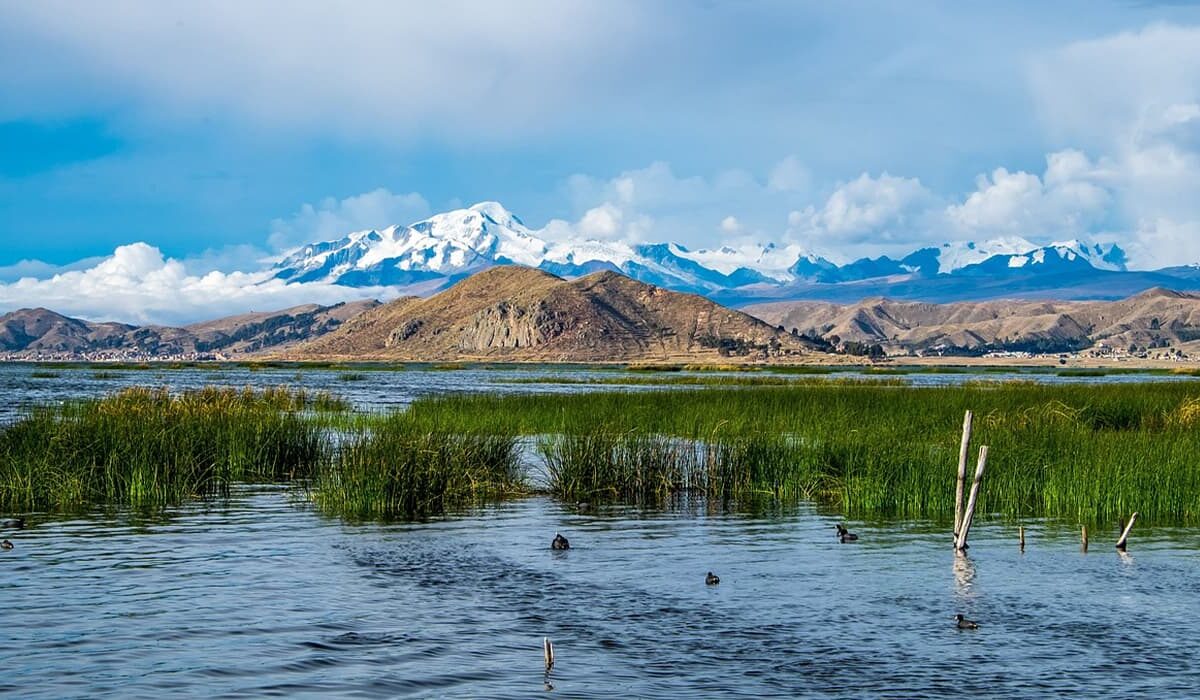Andean Lake Titicaca fascinates archeologists, historians and tourists, and each year tens of thousands of travelers from around the world come to its shores. Some seek to see the ruins of the ancient capital of the Andean Empire of Tiwanaku, or as it is called by scientists “City of the Dead”. Others want to enjoy the beauty of nature and experience the original culture of the Indian tribes.
The name of the South American lake was invented by the Spaniards who colonized the continent and they used the language of the Quechua Indian people. The word “caca” was used by the descendants of the Incas for the rock, and “titi” for the puma. It is noteworthy that the beautiful wild cat was considered by the brave and bellicose Quechuas as their totem animal.
Before the arrival of Europeans to the south of Lake Titicaca there was a territory of one of the first South American empires – Tiwanaku. Its inhabitants spoke the Puquina language and called the mountain reservoir “Lake Puquina”. The Aymara Indians called it “Mamacota,” and today the locals call the majestic lake “Chuquivita.
How the lake came to be in the mountains
Scientists have always been interested in the history of the origin of the lake, which lies at an altitude of 3,812 meters above sea level. How could such a vast reservoir of fresh water appear in the mountains? Geological studies have shown that about 100 million years ago the lake was located 3.7 km lower. It was a large saltwater lagoon connecting to the ocean. Together with the Andes mountain ranges, the bay gradually rose to higher altitudes and became freshwater.
Lake Titicaca in South America
Today, traces of the surf and fossil remains of the inhabitants of the ancient sea can be seen on the rocks surrounding the lake shores. The bottom of the body of water is home to invertebrate marine fish, crustaceans, and some shark species. Although considered freshwater, the lake has all kinds of salts typical of the Pacific Ocean dissolved in its water, and the level of mineralization is quite high at 1%.
Geographic features
Titicaca sits on the Altiplano mountain plateau and is the highest navigable lake on the planet. And there has been regular steamboating here for over 100 years. The Andean body of water also leads as the largest freshwater lake in South America. Titicaca holds 893 cubic kilometers of clear water. Interestingly, the water in the central part of the huge reservoir has a constant temperature of +10 … +12 ° C and therefore never freezes. But near the shores, night frosts often cover the surface of the reservoir with a layer of thin ice.
There are about three hundred rivers flowing into Titicaca, and the total area of the watershed covers more than 58 thousand square kilometers. Like Baikal, only one river, the Desaguadero, flows out of this lake. It is navigable in its upper reaches, but then the freshwater waterway passes through saline soils, becomes shallow, and the water in it becomes salty. Curiously, the Desaguadero takes only 5% of the lake’s volume. The rest of the water evaporates from strong solar radiation and mountain winds.
Underwater mysteries of Lake Titicaca
Since the 16th century, when Europeans began colonizing South America, many scientific studies of the lake and its underwater world have been conducted. According to extant Amerindian legends at the bottom of the Andean body of water rests the ancient Inca city of Wanaku. It was tried to find it several times. In the 1960s, the famous explorer Jacques-Yves Cousteau was looking for traces of the mysterious city, but the lake did not want to give up its mystery.
In 2000, divers from Italy came to Titicaca. Their discoveries amazed the scientific world! At a depth of 30 m, scientists found a long terrace, which looked like an ancient sidewalk, and 1 km under the water was a stone wall. However, the most amazing find was a stone statue in the form of a human head. The same sculptures were found earlier on the ruins of the Indian city of Tiwanaku, which is located 15 kilometers south of Lake Titicaca. The analysis showed that the underwater finds are 1.5 thousand years old.
In 2013, Bolivian and Belgian archaeologists continued underwater research. From the bottom of the lake was raised more than two thousand unique artifacts, which relate to the ancient Tiwanaku empire and to later periods of South American history. Researchers found objects made of gold and silver, as well as stylized animal figurines.
Natural attractions
Titicaca attracts tourists with the beauty of its high-altitude nature. At a distance from the lake shores rise the snow-capped peaks of the Andes. On the northwest coast stretches the territory of the Titicaca National Reserve. The nature reserve, covering 36,180 hectares, was created to protect the unique biodiversity of the mountain reservoir and colonies of nesting and migratory birds.
Since 1997 the shores of Titicaca, covered with reeds, have the status of wetlands of international importance and are protected as habitats for rare species of waterfowl such as ducks, geese, gulls and flamingos. In the waters of the lake inhabits the salmon trout, reaching a length of one meter.

